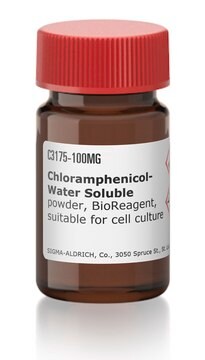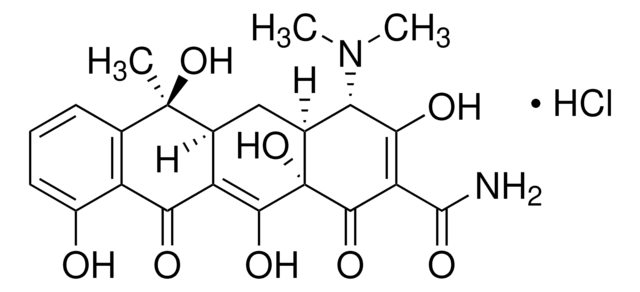C1919
Chloramphénicol
BioReagent, suitable for plant cell culture
Synonyme(s) :
D-(−)-thréo-2,2-dichloro-N-[β-hydroxy-α-(hydroxyméthyl)-β-(4-nitrophényl)éthyl]acétamide, D-(−)-threo-2-dichloroacétamido-1-(4-nitrophényl)-1,3-propanediol, D-threo-2,2-dichloro-N-[β-hydroxy-α-(hydroxyméthyl)-4-nitrophenéthyl]acétamide, Chloromycétine
About This Item
Produits recommandés
Gamme de produits
BioReagent
Niveau de qualité
Forme
powder
Technique(s)
cell culture | plant: suitable
Impuretés
Endotoxin, tested
Pf
149-153 °C (lit.)
Spectre d'activité de l'antibiotique
Gram-negative bacteria
Gram-positive bacteria
mycobacteria
mycoplasma
Application(s)
agriculture
Mode d’action
protein synthesis | interferes
Température de stockage
2-8°C
Chaîne SMILES
OC[C@@H](NC(=O)C(Cl)Cl)[C@H](O)c1ccc(cc1)[N+]([O-])=O
InChI
1S/C11H12Cl2N2O5/c12-10(13)11(18)14-8(5-16)9(17)6-1-3-7(4-2-6)15(19)20/h1-4,8-10,16-17H,5H2,(H,14,18)/t8-,9-/m1/s1
Clé InChI
WIIZWVCIJKGZOK-RKDXNWHRSA-N
Informations sur le gène
human ... CYP1A2(1544)
Vous recherchez des produits similaires ? Visite Guide de comparaison des produits
Description générale
Application
Actions biochimiques/physiologiques
Mode de résistance : La chloramphénicol acétyltransférase acétyle, et donc, inactive le produit.
Spectre antimicrobien : Il s'agit d'un antibiotique à large spectre actif sur les bactéries à Gram positif et les bactéries à Gram négatif principalement destiné à un usage ophtalmologique et vétérinaire.
Attention
Notes préparatoires
Autres remarques
Mention d'avertissement
Danger
Mentions de danger
Conseils de prudence
Classification des risques
Carc. 2 - Eye Dam. 1 - Repr. 2
Code de la classe de stockage
11 - Combustible Solids
Classe de danger pour l'eau (WGK)
WGK 3
Équipement de protection individuelle
Eyeshields, Gloves, type P3 (EN 143) respirator cartridges
Certificats d'analyse (COA)
Recherchez un Certificats d'analyse (COA) en saisissant le numéro de lot du produit. Les numéros de lot figurent sur l'étiquette du produit après les mots "Lot" ou "Batch".
Déjà en possession de ce produit ?
Retrouvez la documentation relative aux produits que vous avez récemment achetés dans la Bibliothèque de documents.
Les clients ont également consulté
Articles
Antibiotic kill curve is a dose response experiment in which mammalian cells are subjected to increasing amounts of selection antibiotic
Antibiotic kill curve is a dose response experiment in which mammalian cells are subjected to increasing amounts of selection antibiotic
Notre équipe de scientifiques dispose d'une expérience dans tous les secteurs de la recherche, notamment en sciences de la vie, science des matériaux, synthèse chimique, chromatographie, analyse et dans de nombreux autres domaines..
Contacter notre Service technique










